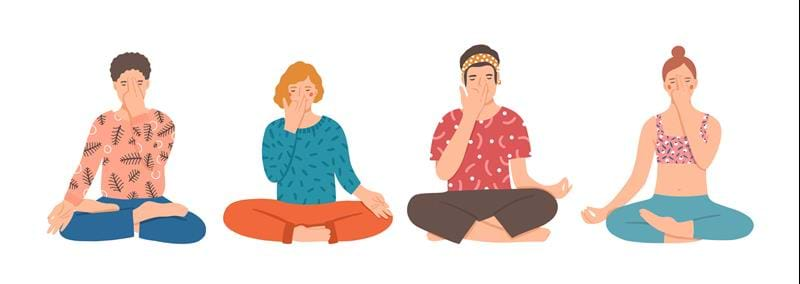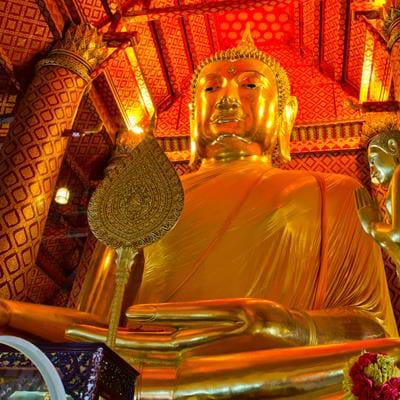India 19.11.2022 David Abrams
What is Yoga?
Yoga is an ancient practice that involves physical poses, concentration, and deep breathing. Regular yogic practice can promote endurance, strength, calmness, flexibility and well-being.
Everyone can and indeed should tap into the benefits of ancient yogic breathing techniques to counter feelings of stress and anxiety at any level comfortable for them. Exercise helps keep the lockdown blues at bay, of course. But there’s another safe and effective relaxant close to hand that will lighten your mood without you having to huff and puff along to fitness gurus on YouTube: meditation.
In India, the re-balancing power of the breath, a form of meditation, has been understood for many centuries. Known as ‘pranayama’, a range of exercises evolved in the yoga tradition which exploited subtle changes in breathing patterns to affect states of mind.
We’ve picked out three of the simplest for you to try at home. Involving slightly slowing or evening out the breath, they’re easy to achieve but highly effective.
Daily pranayama practice can not only benefit the lungs but also greatly improve your mood. How can this be so? The answer lies in the fact that in times of stress we tend to breathe more rapidly. This increases the amount of oxygen in the blood and decreases the levels of carbon dioxide, causing a slight imbalance in the body’s pH levels, thereby negatively impacting what is known as the ‘parasympathetic nervous system’, the complex biological mechanism that keeps us in a calm and balanced state.
Sit Down & Get Comfortable
Pranayama exercises are best undertaken sitting cross-legged on a cushion or comfy carpet, with a straight back and eyes closed. But if you find yourself getting distracted by aches or pains, sit in a chair or lie on the floor instead, with your legs apart and your arms to the side.
Start by concentrating on your regular breathing. For a few minutes, count each inhalation and exhalation in sequence. Try using words if it helps. For example: ‘one Om, two, Om, three Om’ and so on. Don’t be dismayed if you find your out-breaths are longer than your in-breaths – that’s not unusual.
Once you’ve relaxed into your breath awareness you’re ready to try our simple pranayama techniques.
Pranayama for Anxiety
A simple way to combat feelings of stress or anxiety – and improve concentration levels – is to lengthen your out-breath. Begin by breathing normally. Count how many seconds your inhalations and exhalations last for. Then breathe out more gradually, extending your exhalations by a second for one minute. When you’ve achieved that, try making your out-breath two or three seconds longer until you arrive at a rhythm you’re comfortable with.
Next, listen to the sound your breath makes and try to soften it slightly so that it resembles a gentle sigh. Keep concentrating on elongating your exhalations at the same time as softening your breath. Continue for fifteen minutes.
Pranayama For Boosting Energy Levels
This breathing technique involves slightly delaying the inhalation. Again, it can be of overall benefit for your lungs as well as counteracting fatigue.
Start by allowing your body to achieve its regular breathing pattern. After exhaling, pause for a few seconds. Focus on the feeling of the approaching in-breath inside you as it builds, but delay it for a few seconds, allowing the sensation to grow before receiving the breath.
Repeat the exercise for a dozen cycles, then start to make your in-breaths longer, softening the sound they make as you did in the previous exercise. Continue for fifteen minutes.

Alternate Nostril Breathing
Known in India as ‘nadi shodhana’, this pranayama technique involves breathing through alternate nostrils to help calm the nervous system and steady the mind.
Begin by achieving a regular breathing pattern, with the in and out breaths in symmetry.
Using your right thumb, close your right nostril and breath out; then breathe in through the left. Next use your ring and little fingers to close your left nostril, breathing first out, then in. Try to make each inhalation and exhalation the same length. Avoid breathing through your mouth or pressing too hard on your nose. Repeat the cycle nine times.
How Often Should I Practise Pranayama?
Like anything else, the more you practise these techniques, the better you’ll become at them and the more effective they’ll prove. Try to integrate them into your daily routine, or as a wind-down after exercise. A great way to make them more pleasurable is to sit in the sunshine while you do them. The combination of the re-balancing effect and warmth can have a transformative effect.
How to Practise Pranayama in India
If you’ve enjoyed experimenting with these simple pranayama practises, the next step is to consider a health-focused wellness retreat or holiday in India once the Coronavirus crisis has abated. Luxury wellness centres have been created at wonderful locations across the country, from the foothills of the Himalayas to the tropical shores of the Konkan Coast, where you can benefit from expert tuition and complementary cuisine drawing on traditional ayurvedic principles. Our specialists have plenty of suggestions, whether you’re looking forward to a short break in the Keralan backwaters or a two-week yoga retreat next to a tropical beach.










